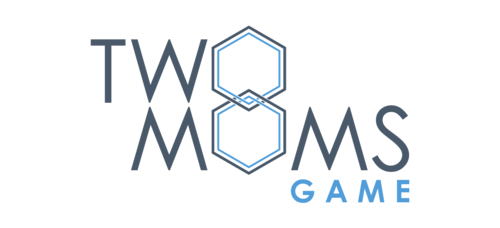A bag building game where players create a trade empire in medieval France
60-90 Minutes
Designer: Reiner Stockhausen
Publisher: Tasty Minstrel Games (TMG)
Orléans is a game that snuck up on us, surprising us with how well it balances elements of luck with challenging long-term planning and strategy.
In Orléans, players recruit farmers, merchants, knights, monks, and more to help them establish and grow their trade network. Normally, we’d say it’s all the fun of medieval economics with none of the plague, except in this case there’s plague in both the game and in real life!
We tend to review a lot of games we like (shocking, we know), but Orléans was like a sleeper agent, hanging out on the edge of our attention and then sneaking up to become one of our recent favorites. In this review, we’ll talk about why this game routinely ends up on our table.
Note: We recently added on the Trade & Intrigue expansion and will never look back. More on this below…
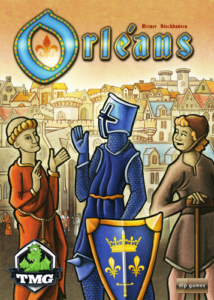
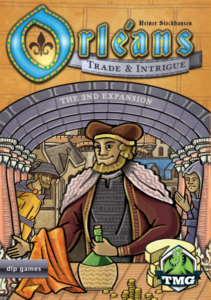
Gameplay Overview
Note: This is a general overview and not a how-to-play, so we won’t cover the rules in detail!
For a game that has so many options and things going on, the turn structure in Orleans is pretty straightforward, which we think would make it a decently approachable gateway game for more adventurous newbies. All players begin with their core 4 followers in their bag and play proceeds as follows:
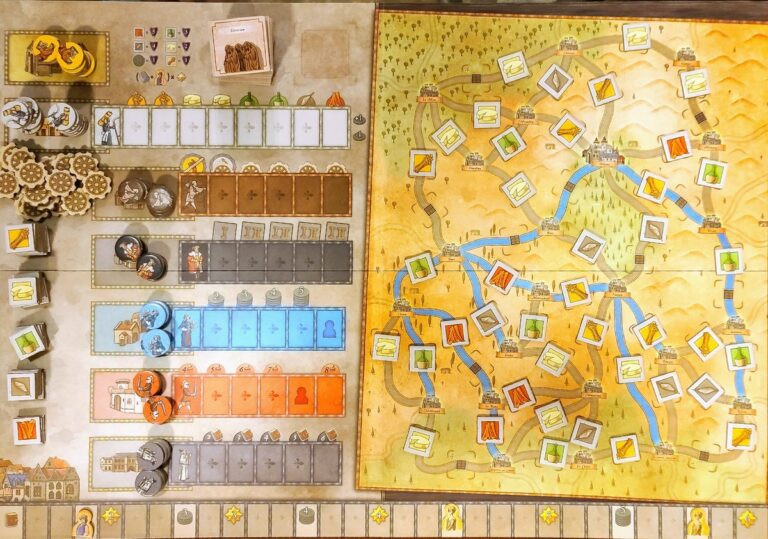
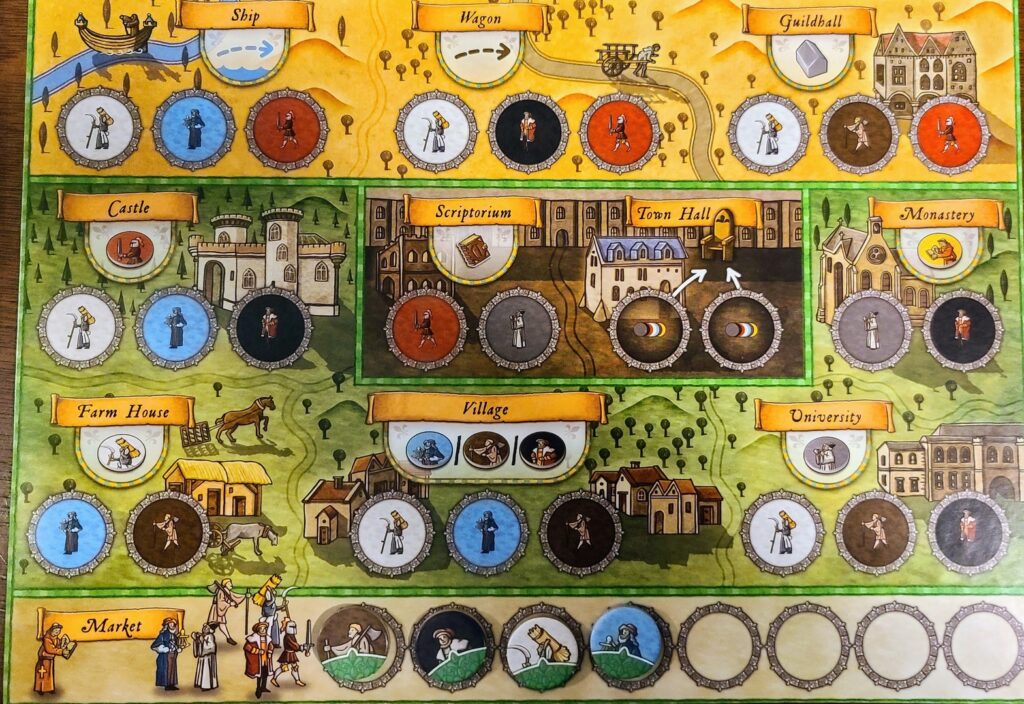
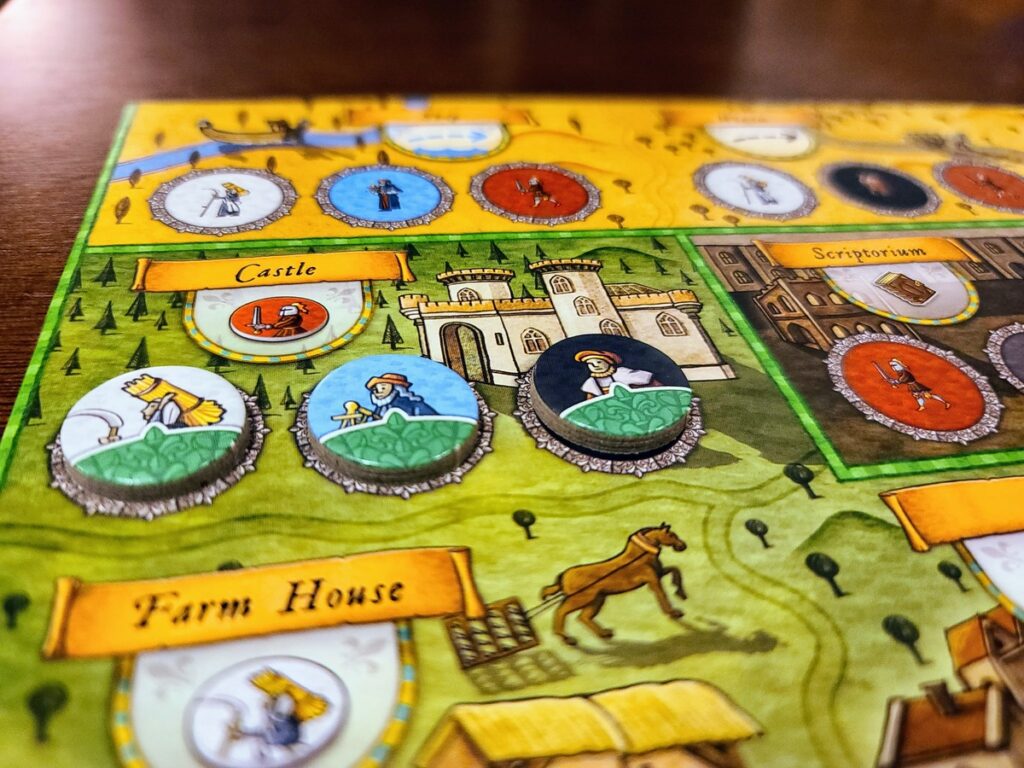
Turn Overview
- Reveal event tile
- Check farmers
- Furthest along track receives 1 coin
- Last place pays 1 coin
- Simultaneously draw followers from bag
- Simultaneously place followers on action spaces of player mat to choose actions
- Types of action spaces
- Get followers: Farmer, Boatman, Craftsman, Trader, Scholar, Knight, Monk (wild)
- Move on map
- Ship
- Wagon
- Build guildhall on map
- Advance on development track
- Send workers to the Town Hall (central board)
- Players may add action spaces to their player mat throughout the game that have unique actions
- Types of action spaces
- Perform actions in turn order
- Each follower has a unique action or result (e.g. increase bag draw amount) associated with the “get follower” action
End of Turn Wrap-Up
- Resolve event tile
- End of turn clean up, pass start player
The game ends after the last event tile is resolved (18 rounds).
Trade & Intrigue Expansion
This expansion doesn’t change the overall game structure, but does change the way you play. It modifies spaces based on player count, adds a new “Beneficial Deeds” board to replace town hall, new tiles, new events, and “contracts” (goal cards). It also adds more opportunity for player interaction.
What do we think?
(Spoiler: we love it)
We had Orléans on our BGG wishlist for a long time, but always prioritized other games (we have a looooonnggg wishlist, y’all). It doesn’t particularly stand out in a field of games that’s flooded by medieval European themes with cartoony artwork. We were also skeptical about the bag building element after hating another bag building game years ago. We tend to lean away from games with a major luck mechanic, and deckbuilders (bagbuilders in this case) toe that line of luck and strategy, some more successfully than others.

When our friends got Orléans and insisted on playing, our doubts were gone. After a single play it became a must buy for both of us and skyrocketed up to one of our favorite games. Why? It’s engaging, fun, and more interesting than it seemed at first. And, dammit, there’s something thrilling about pulling exactly the right workers out of those soft, high-quality bags.
As skeptical as we were about the game’s balance of luck vs. strategy, we think Stockhausen pulled it off brilliantly in Orléans. To be successful, you need to have a long-term plan, but you also need to be flexible and reactive to what you draw from your bag. Instead of being a gimmick, the bag building adds just enough randomness to keep you and your opponents on your toes.
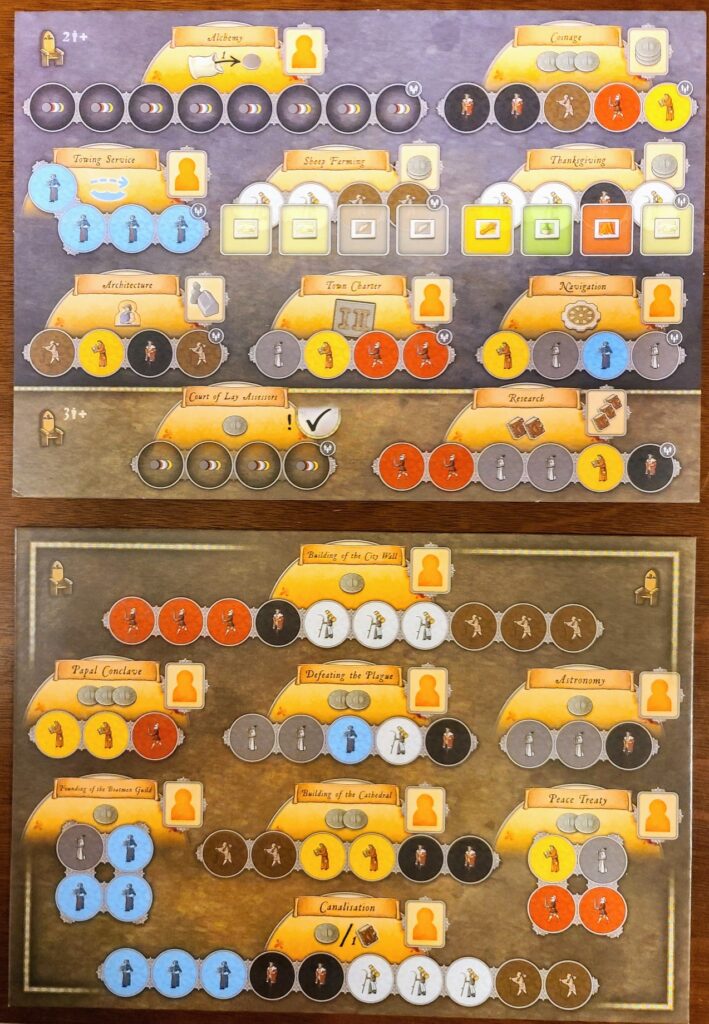
Bottom: Original Town Hall with no scaling
Any Complaints?
Like most games, there are some things that don’t work great in Orléans, but we don’t think the big issues are un-solvable or should deter you from trying it out. The only big one is that the base game, for us, felt broken at 2-players, which almost made us give up on it right after getting it. In short, there aren’t enough ways to get citizens, which in a 2-player game we feel has an unbalanced impact on final scoring. We didn’t see as much of an issue with this at 4-player, since it’s more likely that you’ll be able to get citizens from the town hall. If you want to play at 2, you at least need the Trade & Intrigue expansion, which is excellent and for us solved a LOT of the 2-player balance issues we found as well as adding some other elements that are super fun like contract cards (goals).
The only other complaint we really had was that early game decisions and luck can make or break your game. Orléans can start off a bit slow and if you have a couple bad bag draws or if you make a bad decision or two early on it can really set you back.
Iconography at its best
We have mentioned in other reviews how we can be suckers for good artwork and quality pieces (especially Emily), but the same goes for great iconography (those pictures on the board that serve as instructions or reminders). If you are an experienced gamer, the iconography in this game is so spot on that you’ll likely already have a good idea of how to play the game from just studying the board. And if you’re not, we think it will make learning this game so much easier than games in its weight class. It’s clear, intuitive, and will help you be on your way playing pretty quickly. Our friends Brittany and Kyle taught us this one, and about halfway through the explanation we looked at each other and were just like “oh yeah, I totally see where this is going, let’s play”. That’s how intuitive the iconography is.
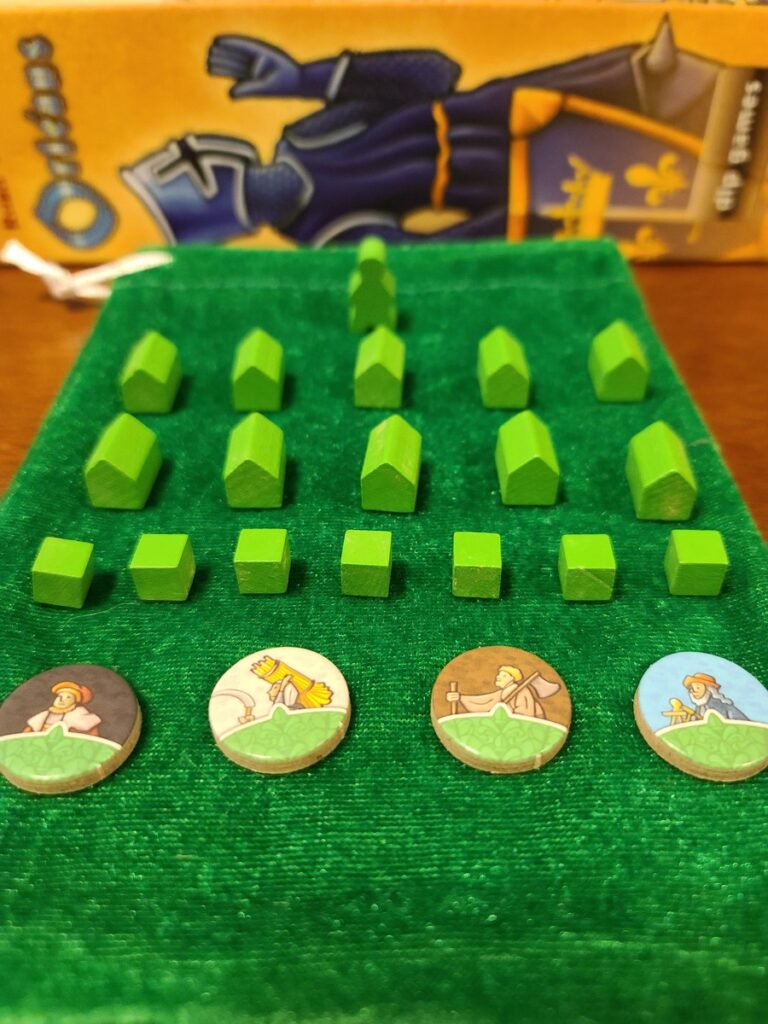
Sarah's Take
I really like Orléans. Maybe not quite as much as Emily who is always down to play and will often suggest a game of Orléans. I think one of my favorite things about Orléans is that there is almost always something to do, even if you don’t get the draw you were hoping for from the bag. You can either set up to have a big turn on your next turn, or still find an action to take that will advance your strategy. Is there a wrong answer? I don’t know! I often go for the “do stuff now” approach because I’m totally impatient. Emily is always a “wait for the plan to come to fruition” person. We are split on wins so…shrug?
The art is understated and to a passerby it doesn’t make you stop and stare. But, I think that understated approach to art serves a purpose in letting the iconography shine through to keep the game approachable. I will take good iconography over artwork every time.
Emily's Take
I like games where I can have a plan for the next five turns and watch in delight as it all comes together. Orléans both is and isn’t that game. You definitely have to plan, but your bag draws might not cooperate with that plan and you might have to pivot. Instead of getting frustrated by this, I actually think it makes this game unique and interesting, and it part of why I keep coming back to it.
I know some people might like the artwork and the theme, but both are sort of “done” already for me. I get it, it’s a Euro game and has a very typical Euro game theme (medieval Europe), but there are so many amazing games on the market now that a great game with what feels like a copy+paste theme might accidentally get overlooked (we are almost guilty in this case!).
Rating Breakdown
Rulebook / Learning the Game
We were taught the game by our friends who had played before and are generally pretty good at teaching games. With the intuitive iconography it was a pretty easy learning experience. We’ve both read the rule book as well and it is well laid out and easy to understand. Most experienced gamers will have no trouble learning Orléans and it would be a pretty good gateway game for more adventurous new gamers.
First Play
The first play was just the base game at 4 players and was super fun. We both picked up on a couple different strategies right away and rolled with it.
Subsequent Plays
We have played Orleans and the Trade & Intrigue expansion many times now. We did feel that after 3 or so plays of the base game the Trade & Intrigue expansion became necessary.
Pro Tip: It’s worth mentioning again – if playing predominately with 2 players, just get the Trade & Intrigue expansion. It is worth it just for the new beneficial deeds boards that scale by player count.
Parent Perspective
Interruptions
Orleans is both friendly and not so friendly to interruptions from your toddler asking for “a bedtime cherry tomato”. The first 4 phases of a turn happen simultaneously so if you have to step away from the table to supervise tomato consumption, then the whole table stalls out. If you are early in turn order, you may be able to sneak away from the table for a hot second, but fair warning, turns in Orleans tend to be quick with most of the decisionmaking happening during the simultaneous phases.
Orleans maintains that mid-weight feel so that if play is interrupted for a few minutes you are not left completely scrambling trying to remember what you were going to do.
Our suggestion for handling interruptions would be to play through phase four of the turn (all the simultaneous parts) so that you pause after you’ve selected the actions you intend to take during the turn. That way if you’re away from the table for longer than anticipated, your player board holds a record of what your plan was and you can pick up your train of thought a bit faster.
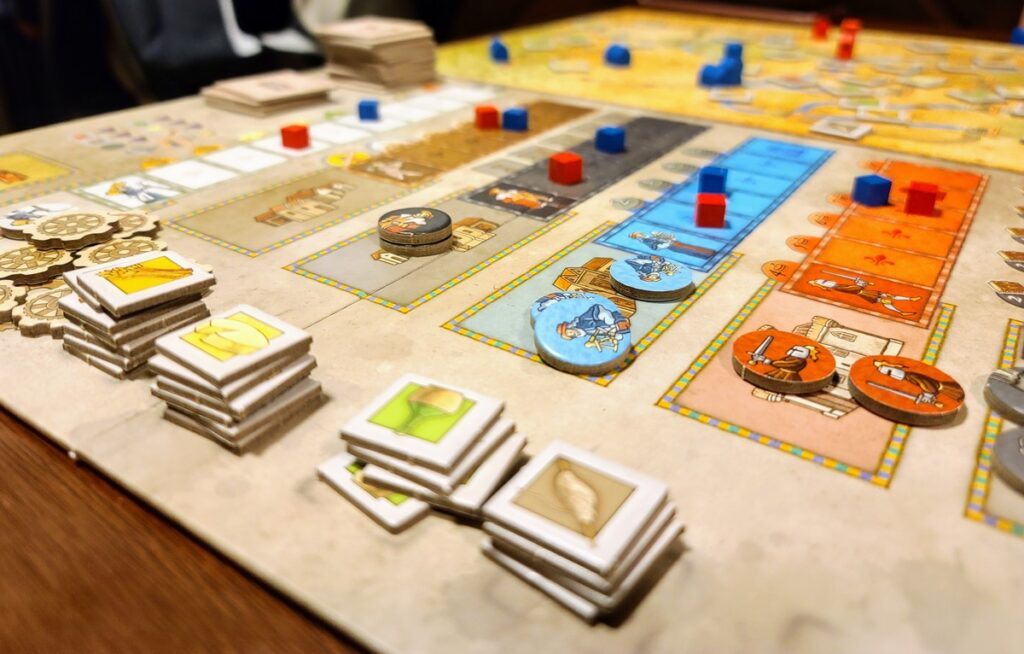
Time Investment
Set up is a pain. There are a bazillion tiles that need to either be placed into piles or put out on the map. At different player counts, various numbers of tiles are removed. But this number isn’t consistent so we always have to refer back to the rules or reference card to remember.
Clean-up is much quicker than set up. While we don’t normally condone putting a bunch of unsorted tiles into a bag and calling it a night, that’s usually what we end up doing with Orléans (which definitely doesn’t help with the set-up complaint). If you have to sort through a bag of tiles and remove several at set up anyway, might as well save time on the clean up.
Because of the front loaded time commitment for set up, one of us will set up the game while the other puts the boys to bed. Once we get to actually playing, we can knock a 2 player game out in just over an hour.
A 4 player game will hit around the 90-120 minute mark.
Life Fit
Orléans is a great “school night game” it can be played in about 90 minutes making it great for when it took longer than planned to put the kids to bed, or when you want to unwind (and stay awake) with an episode of Schitt’s Creek before bed.
Flailing Baby Arms and Clumsy Toddlers
There are approximately 8 million tiles in this game, most of which are tiny and the perfect choking size for a young’n if they were to get at your game and desire to eat some character discs. (This is Sullivan’s life mission. Could whatever I’m about to do potentially kill me? Let’s do it).
The tiles are not so crucially placed that it’s the end of the world if the main board gets bumped. It’s perhaps a bit more annoying if your player board gets taken out by your ungraceful baby or an inexplicably sprinting toddler bumping the table, but it’s generally pretty clear to recognize and remember where everything was.
Overall Rating: 8/10
Orléans hits that sweet spot of interesting decisions to fast and engaging gameplay. It’s a great “school night” game that’s relatively quick to learn (if not set up) and has a great luck vs. strategy balance. If playing 2-players, the Trade & Intrigue expansion is a necessity, as we felt the base game was unbalanced without it.
*See our rating scale HERE
Click through below for more posts, or follow us to see what we’re playing and for new post updates!
